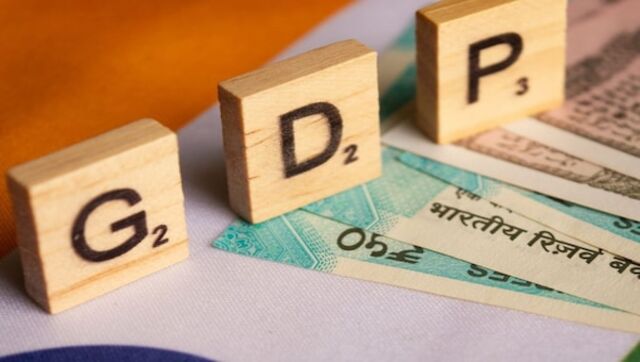
A crowded market outside Dadar railway station in Mumbai. India has surpassed China to become the world's most populous nation with 142.86 crore people, UN data showed. File image/PTI

A crowded market outside Dadar railway station in Mumbai. India has surpassed China to become the world's most populous nation with 142.86 crore people, UN data showed. File image/PTI
We are a crowded country — and the United Nations officially stated that we are more populous than China too. On Wednesday, UN estimates put India’s population at 142.86 crore against China’s 142.57 crore.
This is the first time that India has topped the UN list of most populous countries since it started collecting population data in 1950. The report revealed that 25 per cent of India’s population is in the age group of 0-14 years, 18 per cent in the 10 to 19 age group, 26 per cent in the age bracket of 10 to 24 years, 68 per cent in 15 to 64 years age group, and seven per cent above 65 years.
The new UN report also estimated that the global population will have hit 8.045 billion by mid-2023, by which time almost one in five people on the planet will be Indian.
This data has once again reignited the debate on whether this will be a help or hindrance to India in the long term.
By the numbers: From here to 2050
According to New Indian Express, India is adding 86,000 to its population daily as against China’s 49,400.
A fourth of India’s population is under the age of 15, while more than half is below the age of 30, as per the newspaper.
Only a fourth of China’s population is under the age of 25, as per Fox News.
As per The National, India’s median age is 28.4 years, while China’s is 38.4 years.
In 2020, around 67 per cent of India’s population was in the working group compared to 64.9 per cent for China.
India is projected to have a population of 1.66 billion by 2050, as per Business Standard.
Between 2023 and 2050, India will provide more than a sixth of the increase of the world’s working-age population (15- to 64).
That same year, China’s population is projected to be down to 1.31 billion.
India will be among the eight countries – Democratic Republic of the Congo, Egypt, Ethiopia, Nigeria, Pakistan, the Philippines and Tanzania – accounting for more than half the global population increase by 2050.
Speaking to The Guardian, Swedish physician and academic Hans Rosling put the world’s current “pin code” at 1114.
Rosling explained this meant there are around 1 billion people in the Americas, Europe and Africa and four billion in Asia.
By 2050, the “pin code” will be 1145 with four billion in Africa and five billion in Asia, Rosling explained.
Why is India’s population going up?
According to Fox News, since 1950, India and China have accounted for roughly 35 per cent of the world’s growth in population.
As per BBC, the country witnessed rapid population growth for much of the second half of the past century. The death rate fell while life expectancy increased – all the while birth rates remained high.
The outlet noted that India first launched its family planning programme in 1952 and the national population policy in 1976.
However, in 1975, Indira Gandhi imposed the Emergency.
The forced sterilisations of millions caused a natural antipathy towards the concept family planning.
“Fertility decline would have been faster for India if the Emergency hadn’t happened and if politicians had been more proactive. It also meant that all subsequent governments treaded cautiously when it came to family planning,” Tim Dyson, a demographer at the London School of Economics, told the BBC.
India’s current demographics can be chalked up to a population boom in North India, as per New Indian Express.
Experts note that fertility levels are lower in South India where education is widespread and women go to work.
Experts told the newspaper Uttar Pradesh and Bihar alone will account for a third of the population increase.
What about China?
Meanwhile, China’s population is decreasing.
This comes as a result of Beijing’s stringent family planning rules.
Experts say China faces a huge challenge.

“The Chinese are facing a population contraction that is far greater than anything experienced by Japan or South Korea, and they’re going to be facing it as they’re still only a middle income economy, so this is a huge challenge for them,” Ian Bremmer, the president and founder of Eurasia Group, a political risk research and consulting firm, told The Guardian.
The Chinese age profile will also be transformed.
By 2050, around 330 million people will be above the age of 65 – a figure that’s more than double than the 150 million above that age today, according to the newspaper.
This means the younger generation will have to support increasing numbers of retirees.
According to Bloomberg, some parts of China are attempting to correct the faster-than-expected decline by offering couples money to have children.
“The measures taken to boost birth rates have been far too little and too late, and were completely overwhelmed by the impact of COVID-Zero on birth rates,” Christopher Beddor, deputy China research director at Gavekal Dragonomics, told Fox News.
“The core issue is that there’s only so much policy can accomplish in this realm, because declining birth rates are driven by deep structural factors,” Beddor added. “The leadership seems to have belatedly realized that those issues are very real and arriving very quickly.”
India’s demographic dividend or nightmare?
That’s the question on everyone’s mind.
Some are optimistic.
“For India, the main advantage of the young working-age population is that young people adapt fast and can keep pace with the continuing dramatic and constant technological change,” Vidya Mahambare, professor of economics at the Great Lakes Institute of Management in Chennai, told The National.
Saket Gaurav, chairman and managing director of Indian electronics and brand Elista, added, “India’s large population is one of the most significant opportunities for domestic and international companies.”
It’s a great growth opportunity for various companies, and especially, for value-driven companies like ours, Gaurav stated.
“As a large set of people can produce and consume more goods, it is expected to lead to more economic growth for the country,” says Gaurav. “We consider India’s population as an asset for the business rather than a liability.”
But experts said challenges on providing quality health, education and jobs abound.
India currently spends around 3.5 per cent of GDP on education – which is below the 4.2 per cent global average, as per Business Standard.
The newspaper quoted a 2020 McKinsey Global Institute report as saying India needed to create 90 million non-farm jobs between 2023 and 2030 in order to absorb new workers and an additional 30 million workers who could shift from farm work to non-farm sectors.
“To absorb this influx, India would need close to 12 million additional gainful non-farm jobs every year starting in financial year 2023. This would be triple of the four million non-farm jobs created annually between 2012 and 2018,” the report stated.

India thus needs to increase its GDP 8 to 8.5 per cent annually over the next decade and productivity growth at 6.5 to 7 per cent, as per Business Standard.
“The demographic dividend doesn’t happen automatically, because that big group of young working-age people need to have work and they need to be productive,” Stuart Gietel-Basten, professor of humanities and social sciences at Khalifa University in Abu Dhabi, told The Guardian.
“It will be about resources, about governance, about infrastructure, about location,” Gietel-Basten, said.
Poonam Muttreja of the Population Foundation of India told The Guardian the news was “a fantastic window of opportunity” but warned about that “demographic dividend could turn into a demographic disaster” sans investment in training and education.
With inputs from agencies
Read all the Latest News, Trending News, Cricket News, Bollywood News,
India News and Entertainment News here. Follow us on Facebook, Twitter and Instagram.